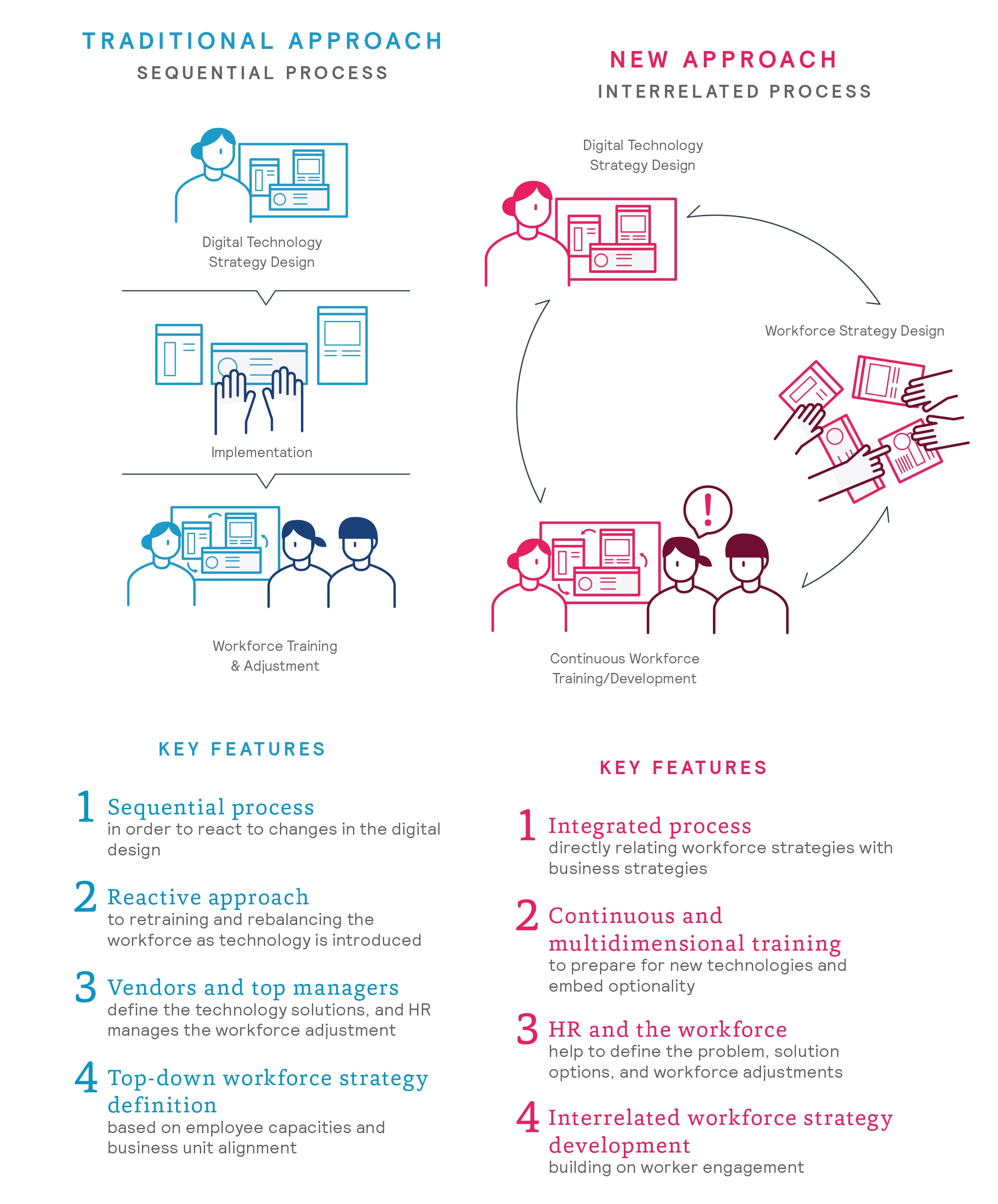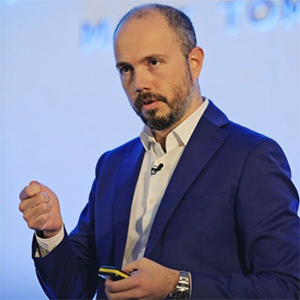“Companies benefit from designing and implementing technology in a thoughtful, integrated way that engages the workforce.”
Digital transformation is here, and it is affecting companies in various degrees, across a number of industries. For an organization to succeed in adopting technological solutions, they must find ways to engage their workforce in this digital transformation or they will fall behind their competitors.
To help determine the best practice approaches towards advancing digital transformation, we recently interviewed managers and employees at the forefront of the digital revolution. We uncovered two distinct findings. The first finding is that the digital revolution is still in its early stages and has yet to have the profound positive or negative effects that many predicted.
In one way this first finding can be seen as an advantage since our second key takeaway from interviews is that the strategies and processes for managing the technological changes are not yet well developed in many organizations, so problems and risks related to the digital transformation and the corresponding engagement of the workforce remain prominent. If companies want to truly improve their productivity, improve their rate of return and produce positive work outcomes through technology, they must first adjust their management of technological innovations.
A new integrated process for designing the workforce for the future
The traditional management process organizations have followed for years has a very sequential pattern. The digital technology strategy design (defined by managers or vendors) flows into the implementation stage, after which the workforce is trained, and workforce adjustments are made (by HR departments). This approach is reactive and often displays a divergence between business targets and workforce strategies –the HR departments are not involved in the design of the strategy, defined by the managers, while the managers are not engaged in the detail of the workforce strategies defined by the HR departments. While this approach can work in some cases, to prepare for the digital revolution – with its fast-paced and more complex changes – we believe a more dynamic and more aligned approach is necessary.
We propose a new integrated model where processes are interrelated and HR and the workforce itself has input in designing technology solutions. The objective of this process is to link the design of the digital strategy with the design of the workforce for the future, from the beginning. Rather than a sequential approach with definite steps, the whole model functions as a continuous circle, without a concrete beginning or end point.
A fundamental difference for this model is that workforce and HR both have a say in the technological problem definition and solution selection as well as the related workforce adjustments. The belief behind this system is that if we want to improve the workforce of the future, we must leverage their input and shape the digital revolution around their needs.

Five key elements for a successful digital transformation
Companies benefit from designing and implementing technology in a thoughtful, integrated way that engages the workforce. By involving in the early stages of problem definition design workers who best understand the processes that can be improved, streamlined, or even eliminated, companies can avoid the changes and bottlenecks that later add costs, reduce continuous improvements, and inhibit user buy-in. Moreover, adhering to sequential technology design-implementation processes, the “old model,” diminishes further innovations that can put technologies to new, unanticipated uses that increase an organization’s digital capacities. Plus, leaving end users/workers out of the early stages increases the likelihood that the new digital landscape will widen the gap between winners and losers in the digital transformation process.
Our interview findings indicate that a successful digital transformation incorporates the following five key elements in a new, holistic model:
- 1. Chief Digital Officer (CDO) as a key enabler of transformation: The CDO serves as the system integrator and change process facilitator.
- 2. Proactive workforce upskilling: Sufficient workforce training and investments made before the implementation process help to ensure the workforce has the skills and the cultural willingness to work effectively with digital technologies.
- 3. Collaborative technology design: Vendors, internal firm managers, and workers jointly define the problems/opportunities that digitization might address.
- 4. Augmenting human input with Artificial Intelligence (AI): Consider systemic process changes via AI (pure AI processes but also AI augmenting humans).
- 5. Integrating technology into workflows: Staff closest to soon-to-be-digitized work brought into the design right from the start. Not only consider automation of existing processes but also think about the process itself (and optimize it).
It is imperative for companies to act swiftly so that their organization does not fall behind the best collaborative competitors in their industry.
Deep-dive: The role of the Chief Digital Officer (CDO)
As business operations change and adapt to the digital revolution, the need for a new executive position becomes readily apparent. Enter the Chief Digital Officer (CDO).
The role of the CDO has been created by some companies to design and lead strategic digitization. Yet, some uncertainty surrounds the role’s responsibilities, given inevitable overlaps with the duties of the Chief Information Officer (CIO) and the Chief Technology Officer (CTO). While no two org charts or reporting arrangements look the same, the CDO, in general, should be understood as a more evolved role, combining elements of the CIO and CTO roles to achieve a mandate of overarching digital transformation throughout the organization.
The CDO will need to be a digital integrator. Beyond extensive technical expertise, he or she must also understand operations and organizational considerations. Such a mix of skills will allow the CDO to approach technology from a design perspective and convert data into a strategic asset.
In our findings, we’ve determined that CDOs must have the following three traits to be effective in their role:
- 1. They must have curious minds and continuously challenge the way an organization operates, plus direct solutions towards the identified challenges.
- 2. They must have advanced technical knowledge so they can select and implement the correct technological innovations.
- 3. They must understand technology and human interactions to manage the ongoing integration and change processes of the new technology.
Many organizations have not yet defined the CDO position, choosing to spread the responsibilities across departments and executives. To compete in the digital revolution, however, companies should begin to consider how a dedicated CDO could impact their technical innovations and workforce engagement.
Case Study
THE SITUATION:
A large global utilities player headquartered in Singapore faced disruptive headwinds from both within and outside of their organization. IoT-enablement of plant equipment meant an exponential increase in both the volume and velocity of big-data sets from multiple sources that they were expected to integrate and analyze. This situation was exacerbated by ambiguity around data security, connectivity, access, and ownership. The proliferation of new technologies and the acquisition of new assets (plants) resulted in a situation where the organization had multiple, incompatible platforms. Their organizational structure also raised some red flags. Their information technology (IT) department was viewed as a cost-center and reported into Finance. The IT team comprised predominantly of generalists, while the specialist services were outsourced.
THE SOLUTION:
Mercer was tasked with designing a new structure for the IT department, as part of a broader digital transformation strategy. Part of our recommendations included the creation of the Chief Digital Officer (CDO) role to drive alignment of their IT and operations technology (OT) objectives and teams. The CDO’s role was designed to develop a digital strategy and elevate digital transformation in C-suite conversations, both from an internal (business analytics and decision making) and external (customer facing platforms and interfaces) perspective. One of the key objectives of the CDO’s role was to ensure that senior executives not only had a holistic view of the ownership and impact of technology decisions but were also invested in driving the outcomes that would deliver returns from these decisions.
1 Engaging the Workforce in Digital Transformation
https://www.mercer.com/our-thinking/career/engaging-the-workforce-in-digital-transformation.html










